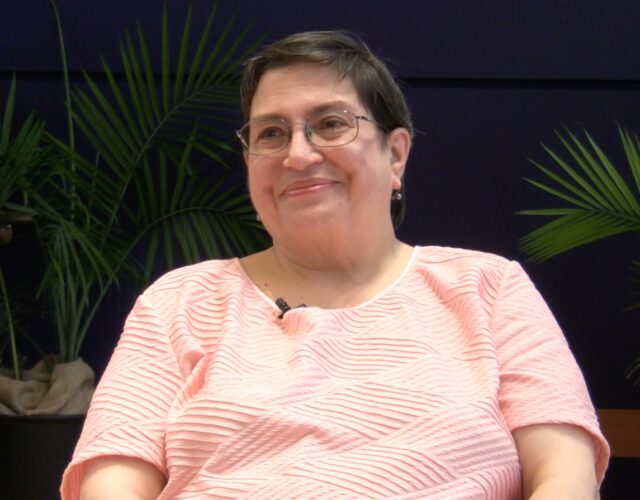In the 1970s Judith, a woman chemist with low vision (pictured above), went to a job interview that took a frustrating turn:
Was the interviewer uncomfortable with Judith’s gender or with the disability he perceived? The answer is likely both. To better understand how this is so, it’s helpful to consider the concept of intersectionality.
Intersectionality has become quite the buzzword in recent years. Although originally confined to college classrooms, it’s been cropping up in recent political battles ranging from the Sanders v. Clinton primary of 2016 to the protests surrounding efforts to repeal the Affordable Care Act. The concept, developed by Kimberlé Crenshaw in the 1980s, grew out of the theoretical and advocacy work of black feminists who sought to express the discrimination they faced both as women and as members of a racial minority. Since its emergence the idea of intersectionality has slowly gained traction. Today the concept is routinely invoked to advocate for a whole host of marginalized identities, including those with disabilities.
But what is intersectionality exactly, and why is it relevant to understanding Judith’s story? At its core intersectionality is about power and privilege. It’s a perspective that acknowledges there are multiple layers to each of our identities—gender, race, economic background, education status, disability, etc.—and that each of these layers of identity can, under the right circumstances, either provide us with access to certain privileges or not.
Since Judith is a woman with disabilities working in the sciences, her life story is best understood with this idea of intersectionality in mind. Her story helps demonstrate what an intersectional perspective can reveal for those who want to better understand the experiences of people with disabilities in STEM fields.
This is exactly what the Science and Disability project at the Center for Oral History is trying to do. Through the collection of oral histories with scientists with disabilities, the center’s staff members are trying to understand the extent to which assumptions about physical ability (often called “ableism”) have shaped the stories we’ve historically looked for and shared in the history of STEM. Through in-depth oral histories with scientists, engineers, and science students with disabilities over the next several years, we’re not only collecting a more diverse record of STEM experiences; we are also building a foundation for intersectional scholarship on the study of STEM histories and cultures. So far we’ve collected a dozen interviews with scientists and engineers who represent a wide range of backgrounds, abilities, and experiences.
One of the themes that has already emerged from this work is the important role that federal policy has historically played in shaping the experiences of people with disabilities. The role of the federal government in creating career opportunities for marginalized groups is a complex but well-documented phenomenon, and people with disabilities are no exception. Federal involvement in promoting employment for people with disabilities began in the 1940s with the institution of “Employ the Physically Handicapped Week.” By 1952 this effort expanded into a year-round presidential committee dedicated to promoting employment opportunities for people with certain kinds of disabilities. At the same time, the World War II and postwar eras saw the expansion of federal funding and support for large-scale scientific research as well as the expansion of federal agencies like the Department of Agriculture and the Food and Drug Administration.
These events had an impact in the lives of people with disabilities who were interested in careers in science. For those who came of age in these decades, employment as a government scientist offered opportunities for people with disabilities, even as the private sector balked at the idea. This was the experience of one of our other interviewees, a male chemist named Jay. Born deaf in 1932, Jay attended the Pennsylvania School for the Deaf before entering a standard high school. Although the switch to standard schooling posed challenges, it likely helped when he later applied to colleges. As a chemistry and zoology student at the University of Pennsylvania in the 1950s, Jay encountered quite a few obstacles and very little assistance. On the verge of graduating with his hard-earned degree, Jay attended a career fair with many of his peers only to find that his deafness caused most employers to dismiss him outright. He recalled,
Notably, those two federal agencies were the only organizations there that day who gave Jay a proper interview—and they both offered him a job. One of them, the USDA, would become his home for the entirety of his career. Though Jay’s deafness marked him as different from his supervisors and peers at the USDA, he shared with them other important markers of identity. Jay has a wife and kids, and his job as a scientist allowed him to fill the normative male role of the breadwinner. This was important to Jay’s sense of his identity and no doubt contributed to his ability to “fit in” to the scientific environment in which he worked.
For women with disabilities, however, career prospects in the sciences have been even more limited. Judith’s identity as a woman entering the sciences in the 1970s was just as important, if not more important at times, in shaping her experiences. Like Jay, Judith found employment opportunities through the federal government, first with the Department of Defense and later with the FDA. Once hired, Judith worked throughout her career to push back against both ableism and sexism. She described one of her first positions where she was the only woman who worked on the materials testing floor: there was no women’s restroom on the shop floor; her colleagues fastened a flower to her hardhat. She laughs about these incidents now, but throughout her career she faced a dual set of obstacles both as a woman and as a person with vision disabilities in the sciences.
The systemic social and gender expectations that historically have kept STEM jobs closed off to women have also worked in similar ways to exclude “other” kinds of people from the spaces in which scientific and engineering work takes place—people of color, people with disabilities, and queer people, to name a few. It’s important for those of us who study the history, practices, and cultures of science to recognize the extent to which our scholarly investigations have also contributed to this exclusion. As we continue to seek out and listen to the stories of people with disabilities who have been involved in STEM over the last century, my colleagues and I are sure to learn more about the ways that intersecting identities, and our historical assumptions about disability and ability, have shaped the stories we tell and the voices we’ve included in our understanding of the history of the STEM fields.




